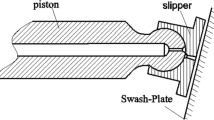Abstract
The bent-axis type of piston pump driven by the piston rod works by the piston rod driving the cylinder block; because of this the taper angle of the piston rod and the swivel angle between the cylinder block and the shaft are important design factors. If these factors cannot satisfy the conditions for optimum design, the friction loss between the cylinder bore and the piston increases, and the pump can fail to work under conditions of severe friction and wear. Since the piston reciprocates in the cylinder bore with high velocity, at the same time rotating on its own axis and revolving on the center of the cylinder block, a decrease of the volume efficiency is generated because of the leakage between the cylinder bore and the piston. Therefore, to prevent this, the piston ring is designed to be at the end of the piston, and the friction characteristics between the piston ring and the cylinder bore require further research due to their great influence on the performance of the piston pump. Thus, in this paper, the elastohydrodynamic lubrication (EHL) analysis of the film thickness, the pressure distribution, and the friction force, have been studied between the piston ring and the cylinder bore in the bent-axis type of piston pump. The analyzed results show that the friction force is influenced by the rotating speed and the discharge pressure.
Similar content being viewed by others
References
D. Dowson and G. R. Higginson, ElastoHydrodynamic Lubrication, Pergamon, 1966.
J. Y. Jung, I. S. Cho, S. H. Oh, The Lubrication Characteristics of a Rotary Compressor used for Refrigeration and Airconditioning Systems, Part 2: Analysis of Elastohydrodynamic Lubrication on Vane Tip, Journal of the KSTLE, 13(1) (1997) 62–69.
R. M. Douglas, J. A. Steel and R. L. Reuben, A study of the tribological behaviour of piston ring/cylinder liner interaction in diesel engines using acoustic emission, Tribology International, Volume 39,Issue 12, December 2006, 1634–1642.
J. Y. Jung, I. S. Cho, K. K. Song, I. H. Baek, S. H. Oh, S. H. Jung and Y. W. Jung, A study on lubrication characteristics between piston ring and cylinder bore of bent-axis type piston pump for vehicle, Journal of the KSTLE, 23(5) (2007) 201–206.
J. Y. Jung, I. S. Cho and S. H. Oh, The Lubrication Characteristics of a Rotary Compressor used for Refrigeration and Air-conditioning Systems, Part 3: Analysis of partial elastohydrodynamic lubrication on vane tip, Journal of the KSTLE, 17(2) (2001) 138–145.
J. Y. Jung and S. H. Jung, Elastohydrodynamic Lubrication on the Vane Tip of Vane Pump, Journal of the KSTLE, 10(3) (1994) 54–61.
Author information
Authors and Affiliations
Corresponding author
Additional information
This paper was recommended for publication in revised form by Associate Editor In-Ha Sung
JaeYoun Jung is currently a professor in Chonbuk National University and a director of Library of Chonbuk National University. He is also working as a director of Automobile High-Technology, Research Institute of Chonbuk National University.
Rights and permissions
About this article
Cite this article
Cho, I., Beak, I., Jo, J. et al. Lubrication characteristics of dual piston ring in bent-axis type piston pumps. J Mech Sci Technol 24, 1363–1368 (2010). https://doi.org/10.1007/s12206-010-0342-3
Received:
Revised:
Accepted:
Published:
Issue Date:
DOI: https://doi.org/10.1007/s12206-010-0342-3



